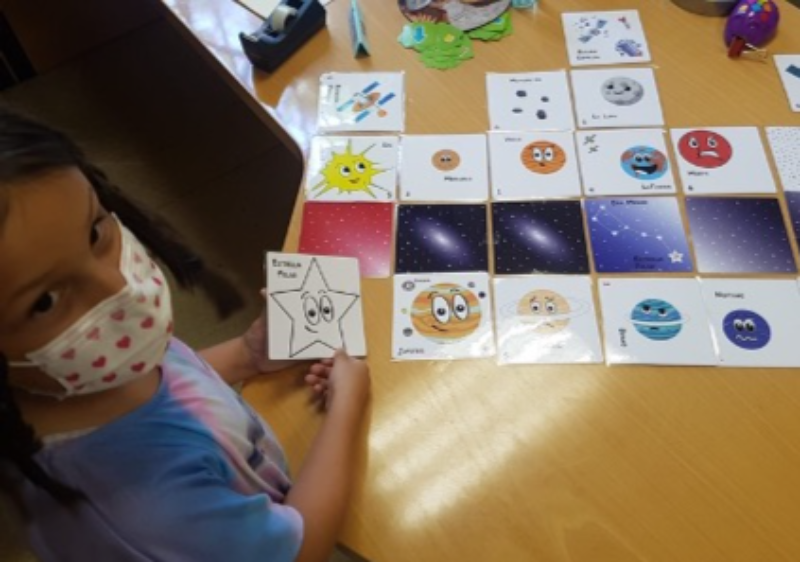An astronomy game: Introducing the Solar System and outer space

The background and importance of the topic
![[left][size=100][/size][size=85][size=100]Fig. 1 Solar System: an adaptation for children
Image source: EESA, [url=https://www.esa.int/ESA_Multimedia/Images/2014/08/Explore_our_Universe_poster]https://www.esa.int/ESA_Multimedia/Images/2014/08/Explore_our_Universe_poster[/url][/size][/size][url=https://www.esa.int/ESA_Multimedia/Images/2014/08/Explore_our_Universe_poster][/url][/left]](https://stage.geogebra.org/resource/ymykvcre/2rjZ92UmTSec30uj/material-ymykvcre.png)
Fig. 1 Solar System: an adaptation for children Image source: EESA, https://www.esa.int/ESA_Multimedia/Images/2014/08/Explore_our_Universe_poster
![[left][size=100]Fig. 2 Solar System: an adaptation for children
Image source: EESA, [url=https://www.esa.int/ESA_Multimedia/Images/2016/09/Rosetta_s_grand_finale]https://www.esa.int/ESA_Multimedia/Images/2016/09/Rosetta_s_grand_finale[/url][/size][/left]](https://stage.geogebra.org/resource/c4rf9maf/Vs2kGwt5xT1EqPig/material-c4rf9maf.png)
Fig. 2 Solar System: an adaptation for children Image source: EESA, https://www.esa.int/ESA_Multimedia/Images/2016/09/Rosetta_s_grand_finale
The activity description
- To know some elements of the Universe, the Solar System (planets and some celestial bodies, including the position and characteristics of the planet Earth compared to the other planets of the Solar System); the rotation of the planets around the Sun and about themselves; the Moon (phases and eclipses) and the existence of other "moons" or natural satellites orbiting other planets.
- To learn about space travel, inventions and technologies used to explore space (such as rockets or the International Space Station) and for our daily lives (such as communication satellites).
- Exercise basic notions of measurement and comparisons (big/small, bigger than...farther than...colder than...) based on.
- Build their own enrichment elements of the activity (according to proposed challenges).
- Take care of the materials and robots.
- Help classmates who need it to program the robot and respect the established turns.
![[size=100][left]Fig. 3 Some commercial models of educational robots: Bee-bot®, Code&Go®, Coding-Critters®, and Pro-bot ®
Images source: [url=http://www.tts-international.com]www.tts-international.com[/url]; [url=http://www.learningresources.com]www.learningresources.com[/url] [/left][/size]](https://stage.geogebra.org/resource/ynevpj54/KbEwzE6VLBf3WSYE/material-ynevpj54.png)
Fig. 3 Some commercial models of educational robots: Bee-bot®, Code&Go®, Coding-Critters®, and Pro-bot ® Images source: www.tts-international.com; www.learningresources.com
![[left][size=100]Fig. 4 Example of game board design.
Photos by: Elena Peribáñez[/size][/left]
[size=100]* The design of the game pieces and/or game board can be done by the teacher (drawing or retouching of photographs by means of an application); or they can be painted by the students on paper or cardboard.
** For the design of cards, board, or stages: consider the distance in wheel rotation (code&go, 12 cm)[/size]](https://stage.geogebra.org/resource/aemkdkk7/aHNYLxrvkpSvVkut/material-aemkdkk7.png)
Fig. 4 Example of game board design. Photos by: Elena Peribáñez
* The design of the game pieces and/or game board can be done by the teacher (drawing or retouching of photographs by means of an application); or they can be painted by the students on paper or cardboard. ** For the design of cards, board, or stages: consider the distance in wheel rotation (code&go, 12 cm)The activity solution
![[size=100][left][/left][/size][size=100][left]Fig. 5 Example of a game mat designed by the student to create her own spatial challenge, explaining the order given to the selected cards. Photo by: Elena Peribáñez[/left][/size]](https://stage.geogebra.org/resource/aahsgrck/IGBuMBg2I3C0g1FR/material-aahsgrck.png)
Fig. 5 Example of a game mat designed by the student to create her own spatial challenge, explaining the order given to the selected cards. Photo by: Elena Peribáñez
A demonstration video
Enhancing the Activity
![[size=100][left][/left][/size][left][size=100]Fig. 6 Example of the creation of an ad hoc AR app for the Solar System activity, using the Unity 3D[sup][3][/sup] engine with the Vuforia toolkit[sup][4] [/sup]Photos by: Carlos Garre[/size][/left]](https://stage.geogebra.org/resource/p6pdd6vd/VeF0uG8aLo9Vbgpi/material-p6pdd6vd.png)
Fig. 6 Example of the creation of an ad hoc AR app for the Solar System activity, using the Unity 3D[3] engine with the Vuforia toolkit[4] Photos by: Carlos Garre
The knowledge test
Where did the first astronauts go to?
What is the largest planet in the Solar Sytem?
- Space junk or debris (what is space junk and why it is dangerous to us?); artificial satellites and space probes (what are they used for?).
- Living in another planet (what would you take with you to a camp on Mars? What rules would you set for living in that camp?)
For special needs’ learners
![[size=100]Fig. 7 Common error detected when starting programming.
Photo by: Elena Peribáñez[/size]](https://stage.geogebra.org/resource/txmvpfxg/PaONEHCSdRrRk26s/material-txmvpfxg.png)